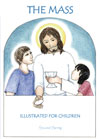Happy Christmas 7 December, 2006
We would like to wish all our readers a very happy and peaceful Christmas.
The great majority of people will go on observing forms that cannot be explained; they will keep Christmas Day with Christmas gifts and Christmas benedictions; they will continue to do it; and some day suddenly wake up and discover why. – G.K. Chesterton
Pope Benedict recently spoke on the meaning of Christmas:
“Why did God become man?” St. Irenaeus writes: “The word has become the dispenser of the Father’s glory for the usefulness of men…. The glory of God is the living man — ‘vivens homo’ — and the life of man consists in the vision of God” (“Adv. Haer,” IV, 20.5.7).
God’s glory is manifested, therefore, in the salvation of man, whom God has so loved “who gave him,” as John’s Gospel affirms, “his only Son so that he who believes in him will not perish, but have eternal life” (John 3:16). So love is the ultimate reason for Christ’s incarnation.
Eloquent in this respect is the reflection of the theologian Hans Urs von Balthasar, who wrote: God “is not, in the first place, absolute power, but absolute love whose sovereignty is not manifested in keeping for himself what belongs to him, but in its abandonment” (“Mysterium Paschale” 1,14).
I can’t resist adding these wonderful remarks by Pope Benedict to university students on 14 December:
Christmas is appropriately emphasized by the many gifts that people give to one another in these days. But it is important that the principal Gift of which all other gifts are a symbol not be forgotten. Christmas is the day on which God gave himself to humanity, and in the Eucharist this gift of his becomes, so to speak, perfect….
The Eucharistic mystery is the privileged point of convergence between the various contexts of Christian life, including that of intellectual research.
Encountered in the liturgy and contemplated in adoration, Jesus in the Eucharist is like a “prism” through which one can penetrate further into reality, in the ascetic and mystical, the intellectual and speculative, as well as the historical and moral perspectives.
In the Eucharist, Christ is really present and Holy Mass is a living memorial of his Pasch. The Blessed Sacrament is the qualitative centre of the cosmos and of history. Therefore, it constitutes an inexhaustible source of thought and action for anyone who sets out to seek the truth and desires to cooperate with it.
It is, so to speak, a “concentrate” of truth and love. It not only illumines human knowledge, but also and above all human action and human life, in accordance with “the truth in love” (Eph 4:15), as St Paul said, in the daily task of acting as Jesus himself did.
Dear friends, let us enter into the mystery of Christmas, now approaching, through the “door” of the Eucharist; in the grotto of Bethlehem let us adore the Lord himself who, in the Sacrament of the Eucharist, desired to make himself our spiritual food to transform the world from within, starting with the human heart.
A progress report on Second Spring
These are the projected contents for issue 8 of Second Spring, which was due out by the end of 2006:
Two Benedicts and the Renewal of Catholic Culture – Carol Zaleski
The Art of Proclamation – Robert Barron
Art of the Spheres – David Clayton
Angels in the Architecture – Stratford Caldecott
Thomas on Beauty – David W. Fagerberg
The Distinctive Agnosticism of Charles Darwin – John Hedley Brooke
Wolfgang Amadeus Mozart – Kenneth Asch
Implementing the Reform of the Reform in Parishes – Shawn Tribe
Plus Poem, Bookwatch, Reports, Last Things
The need to develop a programme of short courses and other events under our new umbrella organization, ResSource, has caused some delays in the editing and production of the new Second Spring, but we hope to send issue 8 early in 2007. Thanks for your patience. I hope to make an announcement shortly about improved publication arrangements for Second Spring that will take effect in 2007.
At the beginning of another year, thanks for your interest and support.
[Picture credit: Icon of the Nativity by Solrunn Nes.]






 We are excited to have persuaded Clare Asquith to teach this new method of reading Shakespeare for the first time on our summer course. Together with the other lectures and events we have planned, the summer school will provide a unique educational adventure for anyone interested in the culture and religion of Elizabethan England. We have even booked a trip to Stratford to see the Royal Shakespeare Company’s production of The Tempest, with Patrick Stewart (better known as Captain Jean-Luc Picard) as the wizard Prospero. Places on this course will be highly sought after, so we advise you to write soon for further information and if possible make a provisional booking.
We are excited to have persuaded Clare Asquith to teach this new method of reading Shakespeare for the first time on our summer course. Together with the other lectures and events we have planned, the summer school will provide a unique educational adventure for anyone interested in the culture and religion of Elizabethan England. We have even booked a trip to Stratford to see the Royal Shakespeare Company’s production of The Tempest, with Patrick Stewart (better known as Captain Jean-Luc Picard) as the wizard Prospero. Places on this course will be highly sought after, so we advise you to write soon for further information and if possible make a provisional booking.